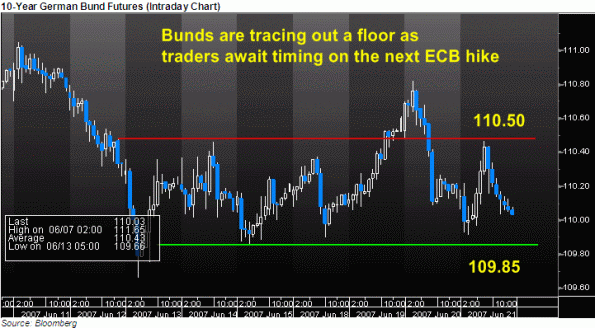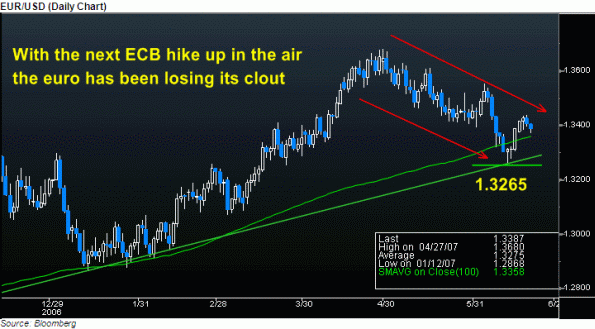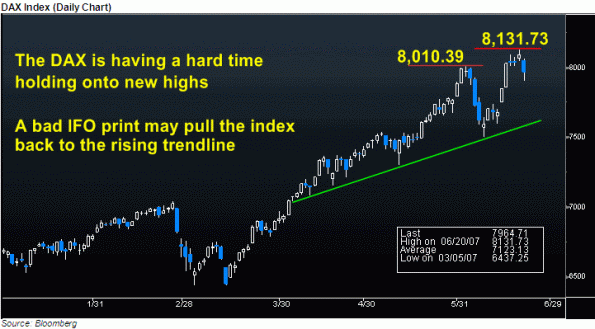| German IFO May Force the Euro To Test Support Once Again |
| By David Rodriguez |
Published
06/21/2007
|
Currency
|
Unrated
|
|
|
|
German IFO May Force the Euro To Test Support Once Again
German IFO-Business Climate (JUN) (08:00 GMT
Expected: 108.4
Previous: 108.6
German IFO-Current Assessment (June) (08:00 GMT)
Expected: 112.2
Previous: 112.5
How Will The Markets React?
Economists are forecasting a steady bearing for business confidence in this month’s IFO report. The Business Climate measurement of the survey is predicted to cross the wires down 0.2 points from May’s print with a 108.4. Such a slim dip wouldn’t dampen traders spirits since it would be only slightly below the indicators all-time high. The gauge marked its highest read in its short history (going back to 1991) back in December at 108.7. After a brief dip as managers battened down the hatches for a possible backlash from the VAT tax hike, optimism has come screaming back. Many of the same factors that have driven sentiment to its highs over the past month were going strong through this month. Domestic demand has ramped up to add a significant booster to sales. German shoppers continue to spend despite the hike in bottom line costs that resulted from the rate hike. Strong earnings growth and an unemployment rate at a 6-year low have played no small role in this. For a marker on consumer optimism, GfK’s sentiment report hit a five-month high over the same period. Foreign demand will have also played its role in business activity. However, this is where the actual read could get a little messy. The euro is up 6 percent on the year; and one of Germany’s largest trade partners – the US – has seen a drop a tremendous drop in growth. The most concerning argument for a steeper than expected drop in the IFO’s report Friday morning though was the sharp contraction in investor confidence. The outlook component on the June ZEW survey unexpectedly fell from an 11-month high as concerns over further rate hikes from the ECB looked to cut into revenues. With economists and markets certainly looking for another rate hike from the central bank this year, it would not be unusual to see executives harboring the same fears.
Bonds – 10-Year German Bund Futures
Yields on the benchmark bund may have topped out. Futures on the ten-year bund made a quick bottom back on June 13th (yields move inversely to prices); and have been working their way up with higher lows ever since. All of the swing lows since that spike to the 109.66 low have been marginally higher. At the same time, rallies have been held under wraps. This hesitation resembles price action in government debt across the globe. Expectations of further hawkish action from central banks put yields on a new rally. However, the outlook for the ECB is not so clear. While there is heavy speculation of another 25 bp hike, traders are uncertain of when it will happen.

FX – EUR/USD
The euro has seen mixed results in recent price action. Against the British pound, the single currency has given up a considerable level of support and is pressing on to new two-month lows. Measured up against other strong economies, the euro has faltered in its weak attempt to retrace some of its considerable losses. Since March, the EURAUD has lost over 1,200 points and EURCAD has lost more than 1,500 points. Alternatively, paired with the Japanese yen and Swiss franc, the unit continues to rush higher as investors push their capital into the carry trade. So, where does that leave the benchmark EURUSD? The pair is at cross roads for long and short-term direction. Scrolling back in time, there is clearly a strong rising trend line that has ushered price action from the swing low back at the end of 2005. On the other hand, since hitting resistance around 1.3680, a very clear downward slopping trend channel has guided spot right back to the bigger trend. Where does the pair go from here? Tomorrow’s IFO report may give EURUSD some immediate direction. The disappointment that the ZEW report suggests is in the works could accelerate the pair’s recent downturn. A really bad number could regress spot back to the trendline, or test of the 1.3265 low; though it would have a difficult time breaking below that on its own. For a true breakdown in this mature formation, the market would likely need a true shift in rate expectations. As it stands, the Fed will gather soon, though the ECB meet is still a ways off. What’s more, business sentiment is not a key ingredient for ECB President Jean Claude Trichet’s recipe for another rate hike. He is far more concentrated on inflation and foreign and domestic consumption to worry about business activity which is still near its all-time high.

Equities – DAX Index
German equities are struggling to hold onto their gains. Earlier in the month, when traders were able to build the bull momentum off of the mid-March swing low, the exuberance encouraged a big bout of profit taking that pulled the DAX over nearly 500 points off the 8,010.39 high. This was a significant retracement – not just the mild pullbacks sprinkled throughout April. Nonetheless, investors were able to regroup around the technically-significant rising trend line that was born out of lows from early April. Fast-forwarding a few weeks, the index was once again boasting new record highs; and once again those the record proved fleeting. This time topping out at 8,131.73, the chart was forming the same technical setup up seen only a few weeks earlier.
On Thursday, the DAX dropped 1.6 percent, the biggest drop in two weeks. The move developed around a rise in oil prices which in turn had a negative impact on price-sensitive sectors like airliners and automakers. DaimlerChrysler, the regions largest car and truck maker saw its shares drop 2.3 percent on the session to close out the day at 67.62 euros. While vehicle makers were worried about future sales with consumer optimism being left behind at the pump; airliners were expecting the jump in energy costs to hit the bottom line much more quickly through the margins. Shares of Air France suffered a 1.7 percent loss that brought shares down to 34.54 euros. Looking ahead to tomorrow’s fundamentals. A disappointing business sentiment read would certainly finish the drop that the ZEW report started. Even a print that is line with the consensus may not be able to divert the build in momentum to the downside.

John Kicklighter is a Currency Strategist at FXCM.
|